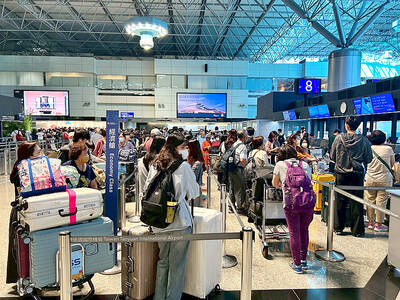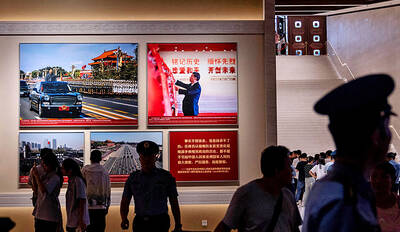Five dried day lily products that were found to contain high levels of bleach have been removed from store shelves in New Taipei City (新北市), health officials said after a series of random checks on food items that are traditionally popular during the Lunar New Year holiday.
The city’s Public Health Department said that earlier this month it tested 185 food items at convenience stores, wholesale outlets and traditional markets and found that five of them contained excessive levels of sulfur dioxide.
All five were dried day lily products and have been removed from store shelves, department section chief Wang Shu-fen (王淑芬) said.
The items contained up to 17.27g of sulfur dioxide per kilogram of dried day lilies, way above the legal limit of 4g, she added.
Sulfur dioxide is commonly used to decolorize and enhance the appearance of day lilies.
Suppliers of the tainted dried day lilies will be fined between NT$30,000 (US$1,000) and NT$150,000 in accordance with the Act Governing Food Sanitation (食品衛生管理法), Wang said.
Consumers should soak dried day lilies in warm water and then boil them for three minutes to get rid of excess sulfur dioxide, she said.
Wang also urged consumers to avoid day lilies that are too bright in color as well as salted melon seeds and pistachios that appear to be too white.
Meanwhile, a report earlier this week said that 51.7 percent of day lilies checked in Taipei between July and last month contained high levels of bleach and that some of those products were from Hualien.
The Hualien County Health Bureau said on Wednesday that 72 percent of the county’s dried day lilies passed sulfur dioxide tests in inspections conducted throughout last year.
Bureau deputy head Lin Yun-chin (林雲欽) said most of the products that failed the checks were from the same suppliers in southern Hualien and the bureau had recalled them.
Taiwan has the technology to produce dried day lilies without sulfur dioxide, Lin said, adding that agricultural agencies could provide assistance.
However, use of that technology tends to reduce the shelf life of the products, Lin said.

Three batches of banana sauce imported from the Philippines were intercepted at the border after they were found to contain the banned industrial dye Orange G, the Food and Drug Administration (FDA) said yesterday. From today through Sept. 2 next year, all seasoning sauces from the Philippines are to be subject to the FDA’s strictest border inspection, meaning 100 percent testing for illegal dyes before entry is allowed, it said in a statement. Orange G is an industrial coloring agent that is not permitted for food use in Taiwan or internationally, said Cheng Wei-chih (鄭維智), head of the FDA’s Northern Center for

The Chinese military has built landing bridge ships designed to expand its amphibious options for a potential assault on Taiwan, but their combat effectiveness is limited due to their high vulnerability, a defense expert said in an analysis published on Monday. Shen Ming-shih (沈明室), a research fellow at the Institute for National Defense and Security Research, said that the deployment of such vessels as part of the Chinese People’s Liberation Army (PLA) Navy’s East Sea Fleet signals a strong focus on Taiwan. However, the ships are highly vulnerable to precision strikes, which means they could be destroyed before they achieve their intended

About 4.2 million tourist arrivals were recorded in the first half of this year, a 10 percent increase from the same period last year, the Tourism Administration said yesterday. The growth continues to be consistent, with the fourth quarter of this year expected to be the peak in Taiwan, the agency said, adding that it plans to promote Taiwan overseas via partnerships and major events. From January to June, 9.14 million international departures were recorded from Taiwan, an 11 percent increase from the same period last year, with 3.3 million headed for Japan, 1.52 million for China and 832,962 to South Korea,

REWRITING HISTORY: China has been advocating a ‘correct’ interpretation of the victory over Japan that brings the CCP’s contributions to the forefront, an expert said An elderly Chinese war veteran’s shin still bears the mark of a bullet wound he sustained when fighting the Japanese as a teenager, a year before the end of World War II. Eighty years on, Li Jinshui’s scar remains as testimony to the bravery of Chinese troops in a conflict that killed millions of their people. However, the story behind China’s overthrow of the brutal Japanese occupation is deeply contested. Historians broadly agree that credit for victory lies primarily with the Chinese Nationalist Party (KMT)-led Republic of China (ROC) Army. Its leader, Chiang Kai-shek (蔣介石), fled to Taiwan in 1949 after losing a